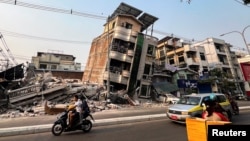The death toll from the powerful earthquake that struck Myanmar on March 28 has risen to over 1,700, with fears that the number could soar in the coming days.
The 7.7-magnitude quake -- one of the strongest the war-torn country has experienced in a century -- also shook neighboring Thailand, causing damage and fatalities there.
The quake in Myanmar left around 1,700 dead, 3,400 injured, and more than 300 missing as of March 30, the Southeast Asian country’s military government said.
International aid agencies also warn of an expanding humanitarian crisis in the earthquake's aftermath.
"The destruction has been extensive, and humanitarian needs are growing by the hour," the International Federation of Red Cross and Red Crescent Societies said in a statement, warning that there was “an urgent need to stabilize” the situation ahead of the monsoon season before secondary crises emerge.
Rescue workers in Myanmar are continuing to search for possible survivors in the rubble of collapsed buildings, and the country’s military leadership has declared a state of emergency across six regions and allowed hundreds of foreign rescue personnel into the country to assist with the quake’s devastating aftermath.
The junta chief, General Min Aung Hlaing, warned that the number of fatalities could go up and his administration faced a challenging situation, state media reported, days after he made a rare call for international assistance.
India, China, and Thailand are among Myanmar's neighbors that have sent relief materials and teams, along with aid and personnel from Malaysia, Singapore, and Russia.
Myanmar’s military government is locked in a fight with insurgents, a situation that could hamper the rescue and relief operation.
The opposition National Unity Government said that anti-junta fighters under its command would pause all offensive military actions for two weeks as of March 30.
Critical Infrastructure Severely Damaged
Across the country of 55 million, critical infrastructure -- including bridges, highways, airports, and railways -- has been severely damaged, hampering humanitarian operations.
The quake comes on top of an already dire situation in a county wracked by a conflict that has battered the economy, displaced over 3.5 million people ,and debilitated the health system.
In some areas near the epicenter in central Myanmar, residents told Reuters that government assistance was scarce, leaving people to fend for themselves.
The U.S. Geological Service's predictive modelling estimated Myanmar's death toll could top 10,000 and losses could exceed the country's annual economic output, Reuters reported.
Hospitals in parts of central and northwestern Myanmar, including the second-biggest city, Mandalay, and the capital Naypyitaw, were struggling to cope with an influx of injured people, the UN Office for the Coordination of Humanitarian Affairs (OCHA) said late on March 29.
The quake also shook parts of neighboring Thailand, triggering the collapse of an under-construction skyscraper in Bangkok and killing at least 18 people across the capital, according to local authorities.
As of March 30, at least 76 people remained trapped beneath the rubble of the collapsed building, where rescue operations continued for a third day on March 30, using drones and sniffer dogs to hunt for survivors.
